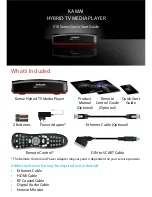
Datacom Systems Inc.
INSTALLATION GUIDE:
1000BT-AT+7C Network Tap
The 1000BT-AT+7C is a non-aggregating network TAP designed for in-line use in 1000BaseT Copper
Gigabit production links. The tapping is non-intrusive and the tapped links will operate at line rate with no
measurable latency. Endpoint devices of the tapped links may be 10/100/1000 Auto operating at 1000
Mbps or 1000 Fixed.
It may NOT be used in 100BaseT links or in links configured to operate at 100 Fixed.
The non-aggregating design provides separate copies of the Rx and Tx traffic thus ensuring that all
packet copies are delivered to the monitoring tools
– there is no potential for internal oversubscription.
Up to seven (7) tools may be attached and should be capable of receiving both Rx and Tx data copies.
This is a non-managed device. There is no operating system, management port or software. The user
cannot assign an IP address
– it is necessary only to connect the cabling and the power supplies.
The TAP consists of two units
– A and B – which are connected together via fiber ports. Unit A contains
the copper Gigabit tap assembly and the first three sets of Monitor ports. Unit B contains the remaining
four sets of Monitor ports.
The data path for both the Rx and Tx copies between the Unit A and Unit B is provided by means of two
short SX (multi-mode) fiber jumpers which are included with the device. If these fiber pairs are ever
replaced it is mandatory that 62.5 micron SX multi-mode fiber be used. C
onnectivity must be from “A Out”
of the A
unit to “A In” of the B unit and from “B Out” of the A unit to “B In” of the B unit.
1.
CONNECTING THE LINK
1. Install assembly in rack
– do not connect power supplies initially
2. Disconnect the existing Cat 5 or higher cable from one of the endpoint devices of the link to be
tapped. Reconnect that cable to the Network A Port.
3. Connect the remaining endpoint device to the Network B port using an additional Cat 5 or higher
cable of appropriate length.
4. Check the two endpoint device to verify that they have established link with one another through the
unpowered tap. If link has not been established then reverse the position of the connections on
Network A and B. The cable end presently connected to Network A should be moved to Network B
and vice versa. Do not change the cable connections where they connect to the endpoint devices.
2.
VERIFYING POWER FAULT TOLERANCE
2.1 Connect the four power supplies. They are load sharing devices and although only one power supply
is required for unit A and one for Unit B it is suggested for highest reliability to use all four and
connect to two separate AC grids per unit. The power indicators labeled 1 and 2 on front panels of
both units should be illuminated if power supplies are functional and properly connected.




















